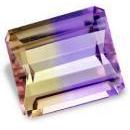|
ClassicGems.net |
|
|
 |
|
Ametrine (variety of Quartz) |
|
|
Discovered in prehistory; IMA status: Not Valid (a variety of Quartz) |
|||
|
|
|
Chemistry |
|
|
|
|
|
SiO2 |
|
|
|
Silicon Dioxide |
|
Molecular Weight: |
60.08 gm |
|
Composition: |
Silicon |
46.74 % |
Si |
100.00 % |
SiO2 |
|
|
Oxygen |
53.26 % |
O |
|
|
|
|
|
100.00 % |
|
100.00 % |
= TOTAL OXIDE |
|
|
|
||||
|
Classification |
|
|
|
|
|
Oxides |
|
|
4/D.01-10 |
|
|
|
4 : OXIDES (Hydroxides, V[5,6] vanadates, arsenites, antimonites,
bismuthites, sulfites, selenites, tellurites, iodates) |
|
Related to: |
Quartz is a polymorph of Coesite, Cristobalite, Stishovite and Tridymite. |
|
Members of Group: |
n/a |
|
Varieties: |
None |
|
Synonyms: |
Bolivianite, Trystine |
|
|
|
|
Crystal Data |
|
|
|
|
|
As
enantimorphic prismatic crystals; may be morphologically
complex, with over 500 forms noted, to 6 meters and
36 tons; |
|
|
Very common, penetration twins on the Dauphiné law, about [0001], and the Brazil law, with [1120] as contact plane; contact twins on the Japan law, with [1122] as contact plane, may be repeated; and several other laws. |
|
|
|
|
|
Physical Properties |
|
|
|
|
|
None or [0110] Indistinct |
|
|
Conchoidal |
|
|
Brittle |
|
|
7.0 |
|
|
2.60 - 2.65 (g/cm3) |
|
|
May be Triboluminescent; varies widely due to traces of impurities. |
|
|
Not Radioactive |
|
|
Other: |
Piezoelectric and Pyroelectric and may be Triboluminescent |
|
|
|
|
Optical Properties |
|
|
|
|
|
Pale Lilac, Violet, Purple |
|
|
Transparent |
|
|
Vitreous (Glassy) |
|
|
1.544 - 1.553 Uniaxial ( + ) |
|
|
0.0090 |
|
|
0.013 |
|
|
Weak |
|
|
|
|
|
Occurances |
|
|
|
|
|
Geological Setting: |
In hydrothermal veins, epithermal to alpine; characteristic of granites and granite pegmatites; in sandstones and quartzites, less abundant in other rock types; in hydrothermal metal deposits. Common in carbonate rocks; a residual mineral in soils and sediments. |
|
Common Associations: |
Calcite, Chlorite, Epidote, Feldspars, Fluorite, Micas, Zeolites, many other species |
|
Common Impurities: |
Fe |
|
Type Locality: |
None (prehistoric) |
|
Year Discovered: |
Prehistoric |
|
View mineral photos: |
|
|
|
|
|
More Information |
|
|
|
|
|
|
Mindat.org
(Ametrine) |
|
|
|
|
Ametrine is the occurance of Amethyst and Citrine together in one gem. It is the purple/yellow variety of Quartz, one of the most common minerals on Earth. Ametrine is availablein a variety of colors, from violet/yellow to deep purple/orange. The color is due to trace elements added to the basic silicon dioxide formula. Natural Citrine gems can sometimes display both violet and yellow colors in striking zonal patterns corresponding to rhombohedral growth regions. Natural Ametrine is somewhat rare in nature but is often artificially created by heating both natural and synthetic Amethyst. These gems are virtually indistinguishable from natural Ametrine gems. Ametrine is named from the combination of the names of AMEthyst and CitTRINE in allusion to the two colors present. The main sources of Ametrine are Rio Grande do Sul, Brazil and La Gaiba District, Sandoval Province, Santa Cruz Department, Bolivia. |
|
|
Ametrine gems for sale: We have not photographed the Ametrine gems yet. Please check back soon. |